History of the House / 1896 to 1901 - John Randal Plunkett
Previous / Next: 1878 to 1896 - The Knox family / 1901 to 1922 - John Pentland Mahaffy
Earlscliffe residents 1896 to 1901
In August 1896 the house was purchased by John Randal Plunkett.
John Randal Plunkett
John Randal Plunkett was the owner of a family malting business in Dublin called Plunkett Brothers supplying the important malt * that went into making beers such as Guinness.
For John Randal Plunkett, the malting business had been in the family for generations.
Family history
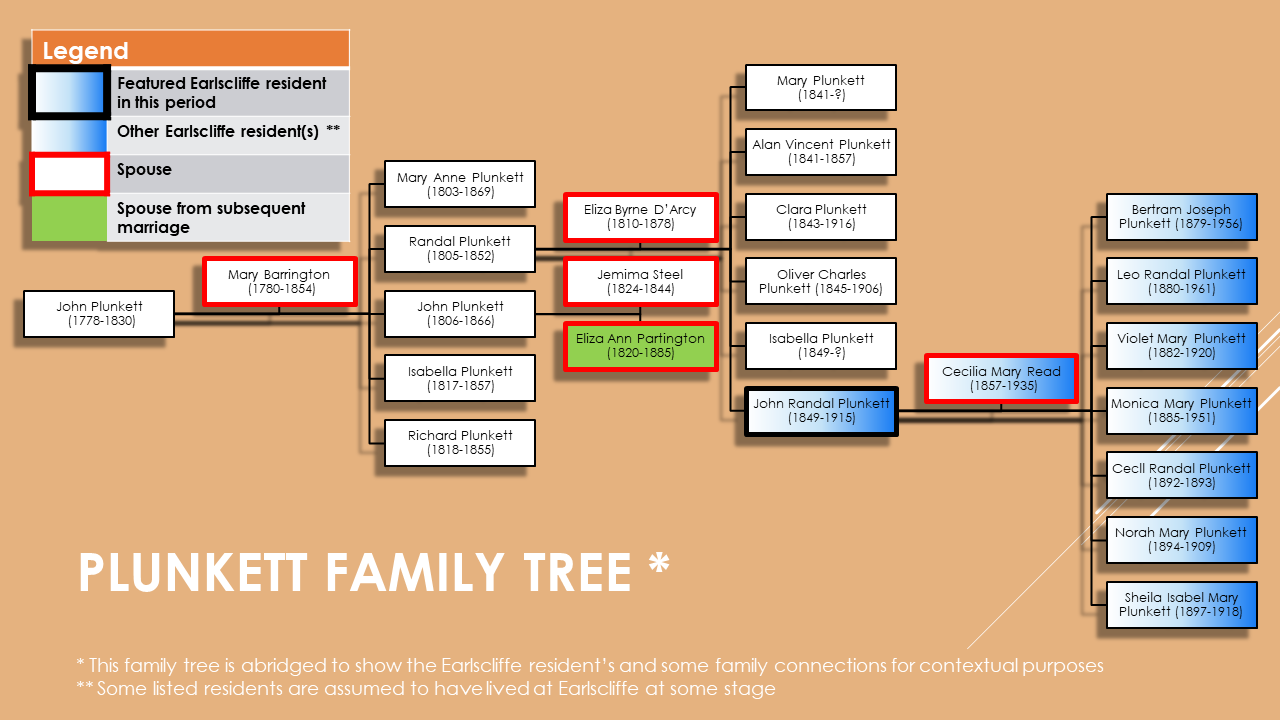
Plunkett Brothers
The malting business, Plunkett Brothers, had been started by his grandfather, John Plunkett in 1819. The grandfather was born in 1778 and had five children. We believe that his eldest son, Randal Plunkett, took over the Malting business from his father. [15]
Randall Plunkett married Eliza Byrne D'Arcy on the 17 Aug 1840 and they had six children. The youngest, born in Dublin in April 1849, was John Randal Plunkett, who would eventually live in Earlscliffe.
Plunkett Brothers supplied Guinness & Co. with their malt (see Plunkett Brothers advertisement below, with a written recommendation from Arthur Guinness, Sons & Co). [1]
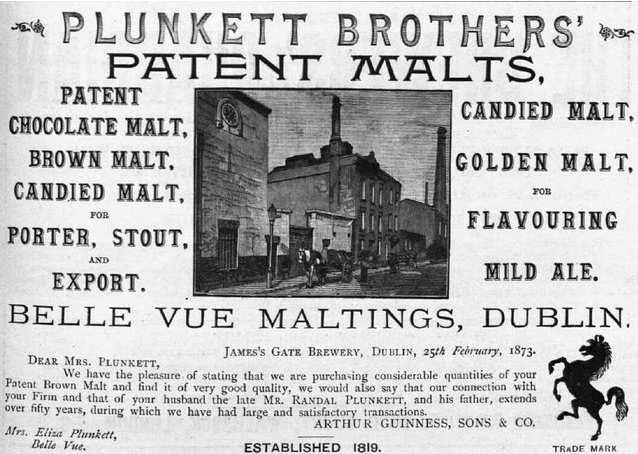
The testimonial from Guinness was addressed to Mrs. Eliza Plunkett, Belle Vue, and read:
Dear Mrs. Plunkett
We have the pleasure of stating that we are purchasing considerable quantities of your Patent Brown Malt and find it of very good quality, we would also say that our connection with your Firm and that of your husband the late MR. RANDAL PLUNKETT, and his father, extends over fifty years, during which we have had large and satisfying transactions.
ARTHUR GUINNESS, SONS & CO.
In a book describing the Industries of Dublin, written in 1887, an article on the Plunkett Brothers, Maltsters and Patent Malt Roasters described their unique malt roasting process and stated that his grandfather had, in fact, invented the process of roasting malt. [2]
Plunkett Brothers vs. John Plunkett & Co. - assumptions or unanswered questions
In our research into the Plunkett family, there are still some unanswered questions around the malting company as there were two companies in Dublin with similar names. The following are my assumptions or unanswered questions (see family tree above). I am currently researching these.
- The Grandfather, John Plunkett, established a Maltsters business at Portland Street, Dublin in 1819. This company supplied all of the large breweries in Dublin such as Guinness, Beamish & Crawford and the Phoenix Brewery. After John died the business was taken over by his son Randall Plunkett. [15]
- One of the Grandfather's other sons, also confusingly called John
Plunkett, went into business with his mother,
Mary Plunkett, trading as Mary Plunkett and
Sons. It is alleged that this company went bankrupt in 1844. [15]
In the Dublin Almanac and General Register of Ireland of 1842 it states that "Mrs. Mary Plunkett & Sons, patent malt manufacturers" were based at on 6 Portland Street. [16] By 1849, The Dublin Almanac and General Register of Ireland now stated that living on 15 Portland Street West at that time was Mrs. Mary Plunkett and John Plunkett, Maltster. As the Grandfather had died in 1830, this "John" must have been their son. Also, as there was no mention in 1849 of the maltster business, maybe it had gone bankrupt by then. [17]
However, there was also a Malting business on Portland Street called "John Plunkett & Co." which was in business by 1887 [18] Was this one set up by the son after his mother's business went bankrupt? - Finally, there was Plunkett Brothers. This is the company with the advert above, which has clear links to Randall Plunkett, and therefore to his son, John Randall Plunkett, who would later own Earlscliffe. The testimonial from Guinness talks about connections going back fifty years to him and his father. As the advert clearly states "established 1819", the date his father set up his business, then this must be his father's business.
Main residence for John Randal Plunkett
John Randal Plunkett's main residence was at 83 Merrion Square South. [3] In the early days, Plunkett Brothers had their premises at Belview, a street off James' Street, as well as other storehouses around the city. But around 1895, about the same time he bought Earlscliffe (probably as a summer residence), Plunkett acquired new premises for the company in Islandbridge, called Bellevue Maltings.
Bellevue, Islandbridge stayed in the family, firstly as a business premises but later also as a residence, until the company was wound up around the 1970's. It is now an apartment complex called Belle View Maltings.
Marriage to Cecilia Read
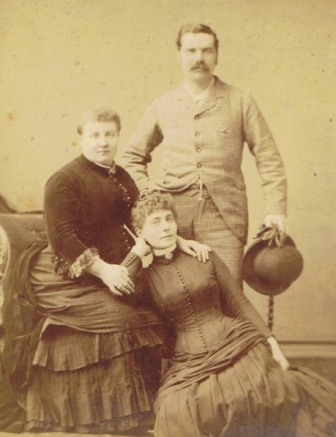
John Randal Plunkett married Cecilia Read from Kensington, London in October1878.
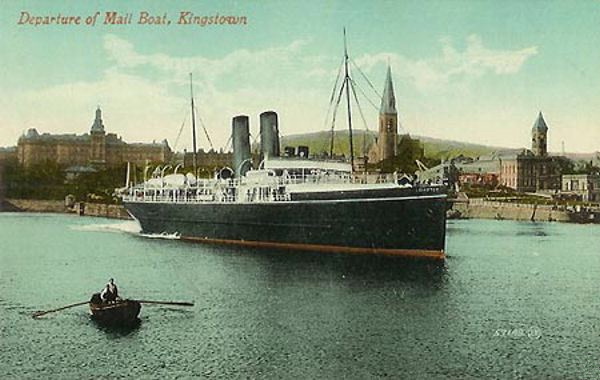
Cecilia came from a well known family of surgeons. Her mother was also called Cecilia Mary Read (nee Landon) and her father was a surgeon called Thomas Laurence Read.
According to Cecilia's father's obituary, his own father was a friend of Dickens and Thackeray! [19]
John Randal and Cecilia had eight children, three of whom died at a young age, including their daughter Sheelagh (Sheila Isabel Mary) who was drowned at the age of 21 when the SS Leinster was torpedoed by the Germans in 1918. [5]
The Plunkett family were related to St. Oliver Plunkett through his niece, Ismay. [4]
Move to Earlscliffe
The Plunketts moved into Earlscliffe in August 1896.
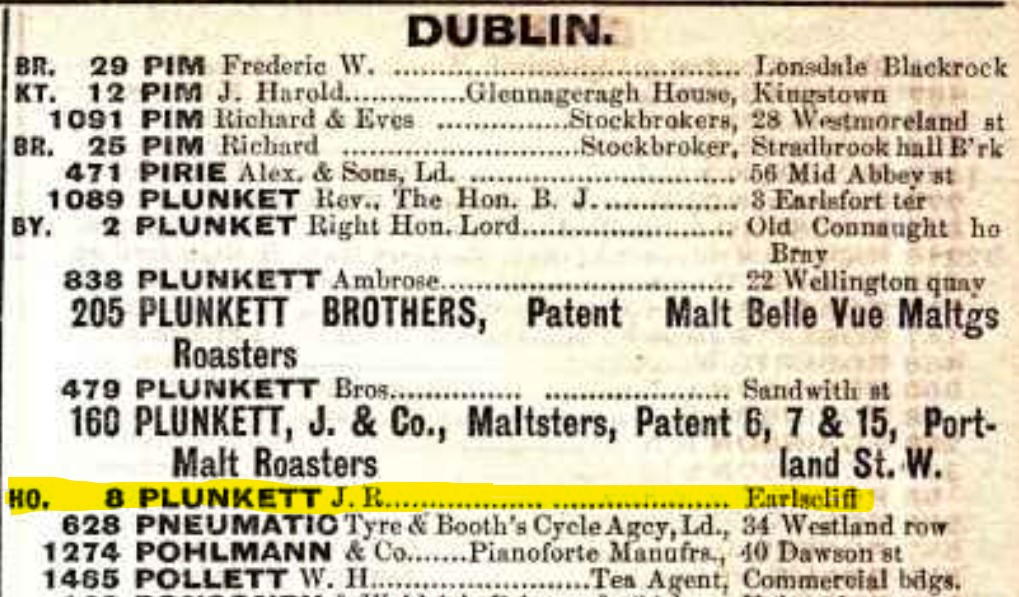
Not much is known about their time in Earlscliffe, although it is noted that they were one of the first people in Howth to have a telephone. In the Dublin District List of Subscribers, the Plunkett family in Earlscliffe had a telephone number of Howth 8! Of course, in those days, there were no direct calls. You rang the exchange and asked for "Howth 8" and they put you through. [10]
1901 Census
As Earlscliffe was primarily used as a summer residence, at the time of the 1901 census (31st March 1901), Earlscliffe itself was unoccupied. However, the property was being managed over winter by the residents in the Gardener's cottage at Earlscliffe. These were Hugh Lynch and his wife Anne. Hugh was the gardener/caretaker and, according to the census, he was 80 years old at that time. His wife, Anne, was 68. Hugh was originally from Co. Meath and Anne was from Wicklow.
In the 1901 census, Earlscliffe was the first house listed on the form for Censure, with the gardener's cottage as the second house listed. Both are said to be owned by R J Plunkett. [9]
The Plunketts did not stay in Earlscliffe too long as the house was put up for rent in June 1901 [6] and in October 1901 Earlscliffe was sold to Professor John Pentland Mahaffy, soon to be Provost of Trinity College Dublin (but not as soon as he would like!).[7]
John Randal died 14th April 1915, three years before his daughter drowned on the SS Leinster. [8]
Footnote
* The importance of malt in the process of making beer
Malting is an important part of the brewing process whereby a grain, usually barley, is steeped in water and allowed to partially germinate. It is then dried to stop any further germination. This malted barley is then roasted and the amount of roasting determines the colour and taste of the beer it will eventually produce.
In order for this malted and roasted barley to be fermented by yeast, it needs to be converted into simple sugars that the yeast will react with.
To do this, the roasted malt is first milled and then the milled malt, called grist, is mashed, which is the process of soaking it in water to allow it to turn its natural starches into sugars which are needed for fermentation. This mash then has more water added to it to wash the sugars off the malted grains to create an extract called a wort which is then separated from the residual grain. Hops are then added to the wort for flavour and then the whole lot is boiled to sterilise the wort. Afterwards this is then cooled and yeast is added to allow fermentation.[11] [12]
As the quality of the malts influences the final taste of the beer, the role of the maltster was very important.
• •
List of Earlscliffe Residents
References
- [1] Advertisement found in "Noted Breweries of Great Britain and Ireland, vol. 3", Alfred Barnard, 1890 , pages 561 - 562.
- [2] "The Industries of Dublin. Historical, statistical, biographical." An account of the leading business men, commercial interests, wealth and growth. Published 1887 by S. Blackett in London . Found on the internet http://openlibrary.org/books/OL22883379M/The_Industries_of_Dublin. on 10th Jan 2019
- [3] The 1901 census information from the National Archives found on the internet http://www.census.nationalarchives.ie/pages/1901/Dublin/South_Dock/Merrion_Sq__South/ on 10th June 2010. At that stage Plunkett was recorded as being a 51 year old Roman Catholic and head of the family! The Thom's Irish Almanac & Official Directory~1897, as listed in "Extracts From Various Trade Directories 1834 To 1910" states that it was 33 Merrion Sq. South, but this is an OCR glitch http://freepages.genealogy.rootsweb.ancestry.com/~chrisu/howth/howth_dir5.htm
- [4] Nearly all of the background and detail around John Randal Plunkett was very kindly given to me by the great grand daughter of John Randal Plunkett, Aideen Byrne.
- [5] Additional information on J R Plunkett's family kindly provided by E. Michael D. Scott
- [6] Irish Times June 15, 1901, pg 11
- [7] A History of the County Dublin, Francis Elrington Ball, originally published in six volumes (1902-1920). Volume 5 "Howth & its Owners" , Chapter 9 "As a Packet Station and After" https://archive.org/details/historyofcountyd05ball
- [8] Calendars of Wills and Administrations, 1915 http://www.willcalendars.nationalarchives.ie/reels/cwa/005014919/005014919_00313.pdf
- [9] As taken from the Census of Ireland, 1901. http://www.census.nationalarchives.ie/reels/nai003675704/
- [10] As seen in "Telephone Subscribers Ireland 1900-1901 https://www.swilson.info/phone1900.php?pageno=14
- [11] As discussed in "The Search for God and Guinness" by Stephen Mansfield, ISBN: 9780718011338.
- [12] See beer - Yeast | Britannica
- [13] See https://www.ancestry.co.uk/family-tree/person/tree/172767915/person/192259856219/facts
- [14] See https://www.ancestry.co.uk/family-tree/person/tree/112023872/person/360092686885/facts
- [15] See https://www.youwho.ie/johnplunkett.html and https://www.youwho.ie/plunkett.html
- [16] See the Dublin Almanac and General Register of Ireland of 1842 https://books.google.ie/books?id=5zc_AQAAMAAJ&pg=PA712&dq=%22mary+plunkett%22+sons+malt&hl=en&sa=X&ved=2ahUKEwiM_cWwrKXzAhWOX8AKHWr2C1IQ6AF6BAhAEAI#v=onepage&q=%22mary%20plunkett%22%20sons%20malt&f=false
- [17] See The Dublin Almanac and General Register of Ireland of 1849 https://books.google.ie/books?id=4BQ2AQAAMAAJ&pg=PA806&lpg=PA806&dq=%22mary+plunkett%22+sons+malt&source=bl&ots=tTbMSoCago&sig=ACfU3U3v03cRBmQoCpCiR0HaDLeMdQtghw&hl=en&sa=X&ved=2ahUKEwii28rTqqXzAhXNesAKHZI4AGEQ6AF6BQimAhAD#v=onepage&q=%22mary%20plunkett%22%20sons%20malt&f=false
- [18] Royal Jubilee Exhibition, Manchester 1887 : official catalogue. See https://archive.org/stream/royaljubileeexhi00roya/royaljubileeexhi00roya_djvu.txt
- [19] British Medical Journal, Feb 6 1909, page 379. https://www.ncbi.nlm.nih.gov/pmc/articles/PMC2318057/?page=1
This page was last updated on 27-Jul-2023 .
